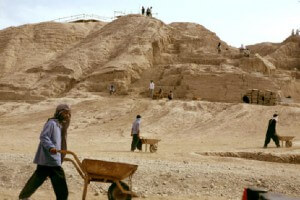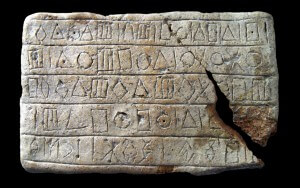
Abaddon
 26. 04. 2024
26. 04. 2024



 31. 01. 2024
31. 01. 2024

For centuries, the prevailing view was that Mesopotamia was the oldest civilization on Earth. Until a 5000-year-old temple was discovered in Jirofta, Kerman Province in southern Iran, archaeologists did not call the site the cradle of the oldest human civilization.
Archaeological work has been carried out in Jiroft since 2002. Many valuable artifacts were found. Among them, for example, two clay tablets with the oldest writing in the world. However, many objects were found by robbers and smuggled abroad to become attractions in museums. Nader Alidad Soleimani, Jiroft's cultural heritage manager, has studied the site for the past 20 years and helped secure the monuments. We bring you an interview with him and more detailed information in it:
Iran Daily: Please describe to us the various stages of the archaeological work that took place in Jiroft.
Soleimani: The first phase of official archaeological studies took place in 2002-2007. The studies then continued after a seven-year break in 2014. I have been researching this region since 1995, long before official research began, because I was aware of the historical significance of the site. The second season of archaeological work in the Esfandagheh lowlands is currently underway. The first season ended last summer. Valuable historical artifacts have been uncovered, such as the Neolithic mansion and the remains of old red and yellow buildings. From February to May 2015, three months of research work followed in collaboration with the University of Tübingen, Germany.
ID: American archaeologists describe the work in Jiroft as the largest project to date in the Middle East  and its importance is also recognized by experts from France, Britain and Italy. Please tell us more about the geographical situation of Jiroft and its importance.
and its importance is also recognized by experts from France, Britain and Italy. Please tell us more about the geographical situation of Jiroft and its importance.
Soleimani: Many believe that Jiroft is just a city bordered by walls. However, it is a large area that once prospered in the Halilroud river basin. The river flows through southeastern Iran - the areas of Jiroft and Kahnuj. It springs in the Hazar Mountains about 3300 m above sea level 100 km northwest of Jiroft. There are many interesting sites in this area rich in cultural monuments. An inscription from the 6th millennium BC was discovered in one of the sites. Every year, various archeological teams come here.
ID: Which countries are involved in archaeological works?
Soleimani: The USA, France, Italy and Germany sent their teams of archaeologists here. However, they can only work under the supervision of Iranian experts. Their activities are limited.
ID: Why are foreign teams needed to dig?
Soleimani: Today, archeology consists of several scientific disciplines. Among other things, ancient botany and osteology contributed to its development. These scientific disciplines are not sufficiently represented in the universities of Iran. At the same time, foreign experts are helping to educate Iranian students.
ID: In the past, there has been illegal activity in the region associated with excavation and smuggling of valuables. What  did the government take action to prevent it?
did the government take action to prevent it?
Soleimani: Illegal excavations caused damage in Jirofta. High-value objects have been smuggled and are now in prestigious museums. The Iranian government is seeking their repatriation. Eighteen artifacts have been restored thanks to the efforts of the former government. It is more difficult to return objects from private collections and museums, as it is difficult to litigate with private collectors.
ID: What funds are invested annually in archaeological research?
Soleimani: The government provides $ 10000 a year for projects in Jirofta, which is insufficient for such an area. The team of archaeologists consists of only 6 people. Such funding increases the risk of illegal excavations. Work is currently being completed to secure and protect historic buildings. Jiroft will be able to serve as an open-air museum and contribute to the development of tourism in the area.